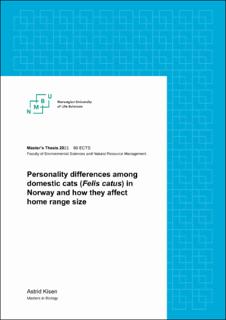| dc.description.abstract | Research on animal personalities has greatly increased in the last few decades, revealing it as an influential contribution to survival and space utilisation. Domestic cats pose a risk to wildlife through disease transmission and predation. The aim of this study was to 1) investigating and describing patterns in owner-reported personality of domestic cats living in Norway, 2) investigating whether these patterns are linked with intrinsic factors or extrinsic factors, and 3) researching whether owner-reported cat personality is related to behaviour, specifically home range size (95% and 50% kernel density estimates (KDE)). It also suggests non-invasive measures to reduce contact between cats and wildlife.
Recruited through social media, participating cat owners completed a questionnaire about their cats and its personality and received GPS equipment to track the cat. Participants rated 16 personality traits on a 5-point Likert scale on whether the trait fit their cat or not. Through PCA analysis, two clusters of personality traits were identified, and the traits energetic and confident were selected from each cluster for logistic regression. As a result of model averaging (candidate models with ΔAIC<2), a cat’s personality being reported as energetic increased significantly when cats required owners to manually open the door to go out, compared to having a cat flap.
No significant effects were found through model averaging for the personality trait confident, but a negative trend was observed where confidence in males decreased with age. No significant effect of personality was found for home range, 95% KDE, only a significant decrease with age, and a significant increase in rural areas compared to urban. For the core area, 50% KDE, the significant effects were a decrease with age, a decrease when cats were manually released outdoors, and an increase as an interaction between age and energetic personality.
This study suggests installing cat flaps as a non-invasive way of reducing the core area of cats, as well as the possibility of restricting energetic cats’ outdoor hours. By reducing the home range and core area of cats, disease transmission between cats and wildlife may decrease as well as predation rates on wild and potentially endangered species. | en_US |

